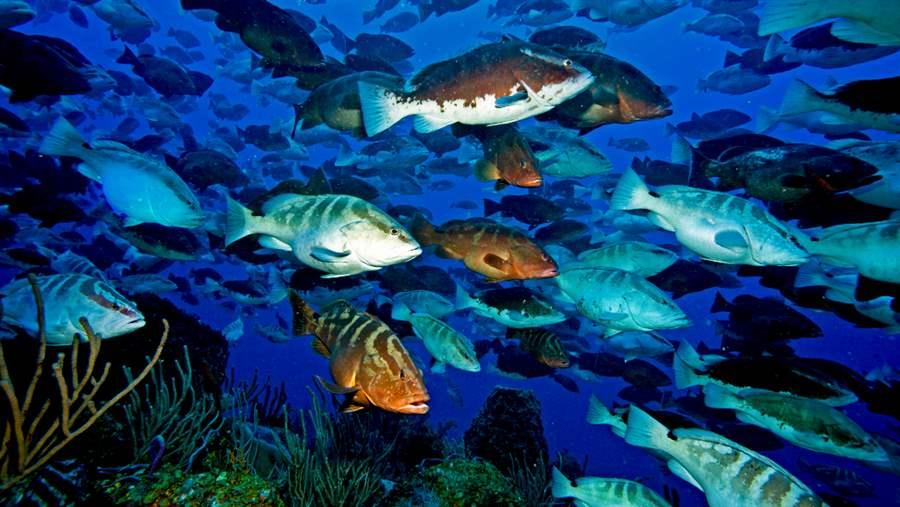Science Comes to the Rescue of Nassau Grouper
 © REEF/Grouper Moon
© REEF/Grouper MoonThe Cayman Islands government enacted comprehensive, science-based protection to ensure recovery of the Nassau grouper, a species particularly prone to overfishing because it reproduces in mass spawning aggregations.
Based on more than a decade of collaborative fisheries research supported in part by the Lenfest Ocean Program, the Cayman Islands government in mid-August enacted a comprehensive set of protections intended to recover and sustain a healthy fishery for the Nassau grouper (Epinephelus striatus), an iconic Caribbean reef fish.
U.S. scientists at the Reef Environmental Education Foundation (REEF) collaborated with the Cayman Islands Department of Environment to evaluate the best way to conserve and rebuild endangered Nassau grouper populations, as part of the Grouper Moon Project.
The resulting data assisted the Cayman Islands government in determining which protective measures would result in the greatest conservation benefit for the Nassau grouper. The new regulations include: closing the fishery during spawning season, from December through April; implementing size limitations, in which fish must be larger than 16 inches and less than 24 inches; limiting fishing vessels to no more than 5 Nassau grouper per day; and banning spear gun fishing of the species.
”We distilled several decades of collaborative science into a set of suggested management actions, each supported by the products of our research.” said Brice Semmens, Assistant Professor at Scripps Institution of Oceanography and lead researcher for the Grouper Moon Project. “The intent of the legislation is to rebuild and sustain a healthy population and fishery.”
The Nassau grouper was once one of the most important shallow water fisheries in the Caribbean. An interactive, curious fish with striking zebra-like stripes, the species provides a unique, sought-after diving experience, which contributes to the local tourism economy. They also play a crucial role in maintaining reef ecosystems in the region.
Nassau grouper are particularly susceptible to overfishing because they reproduce in mass spawning aggregations, where fishermen find them easy targets, and are a slow-growing, large-bodied species. The fish spawns in December and January in the central Caribbean, always around the time of the full moon, and always in the same locations. In addition, with an average length of 1 to 2 feet (0.3–0.6 m) and weight of approximately 10 to 20 pounds (4.5–9 kg), it is one of the largest fish on the coral reefs in which they are found. They are long lived, with some adults living 3 decades or more, and don’t reach maturity until seven years of age.
Unfortunately, the fishery was harvested to the point of collapse throughout its range, from Bermuda and Florida and in the Bahamas and Caribbean Sea. The International Union for the Conservation of Nature added the Nassau grouper to its Redlist of threatened species in 1996 and determined that it was endangered because its population has declined by 60 percent in the past 30 years.
The Cayman Islands were once home to six Nassau grouper spawning sites; today, only two are still active—the west end of Little Cayman and the east end of Cayman Brac. Once fished out, aggregation sites recover slowly, if ever. Since 2003, all known Cayman spawning sites have been protected. Grouper Moon scientists studied the remaining active aggregations, with a focus on the west end of Little Cayman, which houses the largest remaining aggregation of the species anywhere in the world.
“Our goal was to understand the effectiveness of spawning site protections in recovering the species. Interestingly, we found that all mature fish go to spawning sites every year. We also found that these spawning fish spend considerable time outside the spawning site marine protected areas each year. These findings motivated the new legislations – given that all fish are spawners, closing the fishery during spawning season was a more efficient form of management than spatial protections, particularly from an enforcement standpoint,” said Semmens.
Many marine fisheries that aggregate in spawning areas have been fished beyond the point of sustainability, leading to increased calls for protection through seasonal or site-specific fishery closures. Protecting the areas where spawning occurs from fishing pressure is typically cited as the best approach to rebuilding and conserving these populations. However, if fish are no longer aggregating on these sites, additional measures such as catch limits are often needed to successfully rebuild depleted populations. In the case of the Nassau grouper, the data indicated that more comprehensive protection measures were needed to ensure the fish had the best chance at recovery.
“This is the beginning of a fisheries management success story. Populations of Nassau grouper in the Caymans have already showed signs of recovery following earlier spatial protections. With these new science-based regulations, the Cayman Islands have stuck a balance between species conservation and harvest management,” said Semmens. “I expect this model of collaborative, action-oriented science will be replicated many times over the in the years to come.”

